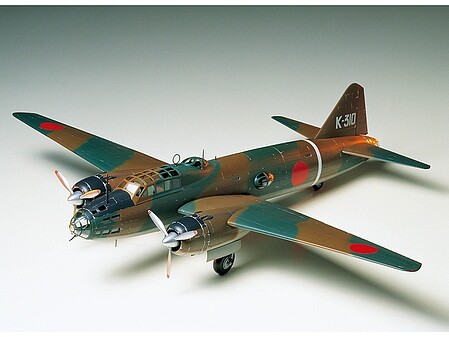Isshiki Rikko Type 11 Betty Aircraft
This is a plastic model kit of a 1/48 Isshiki Rikko Type 11 Betty Aircraft by Tamiya.
You Might Also Like
Features
- Approximately 75 parts in light grey and clear with fine recessed panel lines.
- Full bomb load or torpedo armament.
- Full interior detail
- -Cockpit: Pilot and copilot's seats, control yokes, throttles
- accurate instrument panel (decal is provided for instruments).
- -Aft Fuselage: Full floor, bulkheads and wing carry-through
- structure.
- -Rear Gunners Station: Gunner's seat, machine gun and supports.
- -Bomb Aimers Station: Floor and bombsight.
Specs
- Scale: 1/48
- Wingspan: 20-1/2" (51.8cm)
- Fuselage Length: 16-1/2" (41.6cm)
- Tamiya Product Number: 61049
Includes
1/48 Isshiki Rikko Type 11 Betty Aircraft plastic model kit
Requirements & Suggestions
- Assembly
- Modeling Knife (EXL16001) (XACX3627) (EXL16018)
- Paint
- AS-1 - Dark Green (TAM86501)
- AS-17 - Dark Green (TAM86517)
- AS-2 - Dark Gray (TAM86502)
- TS-1 - Red Brown (TAM85001)
- X-10 - Gun Metal (TAM81010) (TAM81510)
- X-11 - Chrome Silver (TAM81011) (TAM81511)
- X-12 - Gold Leaf (TAM81012) (TAM81512)
- X-18 - Semi Gloss Black (TAM81018) (TAM81518)
- XF-1 - Flat Black (TAM81301) (TAM81701)
- XF-10 - Flat Brown (TAM81310) (TAM81710)
- XF-15 - Flat Flesh (TAM81715) (TAM81315)
- XF-16 - Flat Aluminum (TAM81316) (TAM81716)
- XF-2 - Flat White (TAM81302) (TAM81702)
- XF-22 - RLM Grey (TAM81322)(tam81722
- XF-52 - Flat Earth (TAM81352) (TAM81752)
- XF-56 - Metallic Grey (TAM81356) (TAM81756)
- XF-58 - Olive Green (TAM81358) (TAM81758)
- XF-64 - Red Brown (TAM81364) (TAM81764)
- Paint Brushes
- Sandpaper
- Plastic cement (TES3501) (PLS00002) (TAM87012) or glue (HLC107)
- White Glue
- Plastic cement (TES3501) (PLS00002) (TAM87012) or glue (HLC107)
- Nice-to-have tools: Needle File Set
- Sprue Cutter (XUR410A) (EXL55594)
- Airbrush and
- Accessories
Product Rank
Information
The Rolls-Royce Merlin engine was powering the best warplanes in England early in the war. To develop a new engine for the fledgling P-51 would take much time and the allies did not have it. In 1940, the Packard Motor Company of the U.S. began license production of the Merlin V-1650-1 engine in Detroit. Both the U.S. and England started modifications almost simultaneously. 10 airframes were altered and became the start of the most successful fighter series of the war.
Flying on 30 November 1942, the XP-51B was soon modified with a larger coolant radiator, which increased top speed by 50mph and a higher ceiling by 10,000ft. The 85 gallon fuel cell installed behind the seat allowed it to escort the bombers the target and back. If there was on single fault in the P-51B/C design, it was the canopy. British fighter specifications differed from the U.S. so they requested that a sliding canopy was used on the early Spitfire Mk's for greater headroom and vision.
The low profile canopy of the P-51B/C restricted visibility, and offered considerable discomfort. North American engineers felt it was necessary to reduce drag and maintain the high degree of performance. Even a small pilot was forced to fly with his head pressed against the top of the canopy for adequate vision during take off, landing and combat. The Malcolm hood became a very popular modification as it offered some considerable relief to the pilot.
Markings
- Decal Options:
- 1&2: 705th Naval Fighter Group, Rabaul, 1943, a/c nos. #359 & 360.
- Upper Surfaces: IJN Green.
- Bottom Surfaces: IJN Light Grey.
- 3: Misawa Naval Fighter Group 3rd Squadron, Rabaul, 1942, a/c no.
- H-362.
- Same as 1: except black fuselage top and anti-glare panel.
- 4: 761st Nval Fighter Group, Mainland Japan, 1944, a/c no. 01.
- Same as 1.
- 5: Malaya, Indo-China, December 1941, a/c no. K-310.
- Upper surfaces: IJA Green and Dark Earth camouflage; black anti-
- glare panel; Bottom surfaces: IJN Light Grey.
- 6: Misawa Naval Fighter Group 2nd Squadron, Rabaul, 1942, a/c no.
- H-324.
- Same as 5.
